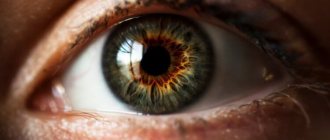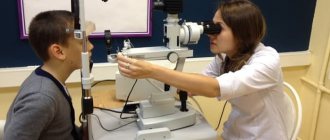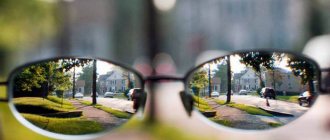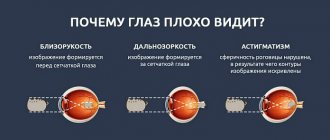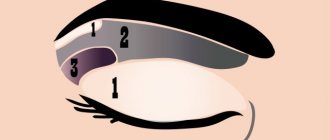Everyone knows that in order to enroll in a driving school, you need to pass a medical examination and obtain permission to drive a car - without this certificate you will not receive a license. In addition, such a doctor's opinion is required if you want to renew your driver's license. One of the doctors who will conduct the examination is an ophthalmologist.
The ophthalmologist's opinion is very important - the driver must have good vision in order to drive the car and see what is happening on the road in order to react in time and prevent an accident.
Vision requirement for driver's license
Assessment of vision to obtain a medical certificate on suitability to drive a vehicle is carried out according to several criteria: acuity, color vision, horizons, etc.
Acuity
According to Order of the Ministry of Health and Social Development of Russia No. 302n , minimum thresholds for visual acuity have been established, which are differentiated depending on the category of driver's license.
Thus, for drivers of categories A and B, whose driving is not related to professional activity, it is required that:
- vision was from 0.6 and above in one eye and from 0.2 and above in the second;
- if one of the eyes is blind, the vision of the second was not lower than 0.8 (any correction is possible);
- a month has passed since the eye refractive surgery .
For professional drivers of all categories, the requirements for visual acuity are higher:
- the vision of one eye should be from 0.8 , and the second – from 0.4. The total score of both eyes should be 0.7 or higher;
- The use of correction means exceeding 8 diopters in both positive and negative directions is excluded. The difference in visual acuity of both eyes should not be more than 3 diopters;
- if a person has astigmatism, then the sum of the cylinder and sphere cannot exceed 8 diopters. The difference in visual acuity of both eyes should not be more than 3 diopters;
- if one eye does not see, the second should see without correction means from 0.8 and above.
- It is not permissible to have chronic eye diseases that create obstacles to the normal functioning of the visual apparatus and cannot be treated (paralytic strabismus, eyelid injuries, etc.), as well as spontaneous nystagmus (eyeballs are located with a deviation of 70% or more from their normal position ).
Color perception
Diagnosis of color perception is a mandatory procedure when opening a driver’s category.
This criterion did not always exist. Today, violation of color perception is the basis for a ban on driving a vehicle professionally.
Since 2012, a complete lack of color perception (achromatopsia) excludes the possibility of fully driving a vehicle, i.e. A positive medical report for a person to obtain a driver's license is excluded.
Determining the degree of color perception distortion forms the basis for the conclusion on the issuance of a certificate for obtaining a driver’s license.
Even with color vision impairments, it is possible to receive it. A corresponding note is made in the certificate.
How does driving a car affect your eyes?
The driver's eyes are under constant tension because his vision is always focused on one object - the road. At the same time, the eyes actively work, trying to catch small details: road signs, holes and potholes, traffic lights, other traffic participants. For this reason, the eye muscles become very overstrained, the person blinks less often, and the mucous membrane of the eye experiences dryness. This constant stress alone can cause a decrease in visual acuity.
Driving and vision while driving is highly dependent on external and weather conditions. In hot and sunny weather, regular alternation of bright light and shadows causes severe eye fatigue, and the driver begins to see worse. In addition, the air conditioner in the car and the surrounding hot weather also affect the mucous membrane, making the air even drier, causing even greater eye discomfort.
In bad rainy weather, at dusk and at night, when it is dark, the strain on the eyes increases, objects are less visible, so the eye muscles become more tense, and the eyes are also exposed to the blinding light of oncoming car headlights. This light causes a white spot on the eye shell and a temporary sharp deterioration in the driver’s vision, so his reaction slows down significantly, which can be dangerous on the road.
Such daily eye strain causes a decrease in visual acuity, impairs the functioning of the eye muscles, leading to chronic dry eyes, a feeling of “sand in the eyes,” irritation and regular headaches.
Level of color perception
Diagnostics are based on Rybkin’s polychromatic tables - sheets with images of elements, most often numbers, made in the same brightness, but different in color.
If a person has color vision impairments, then the image appears to him to be made in one color.
For people with normal vision, distinguishing the image is not difficult. The more images are not recognized or are recognized with errors, the stronger the degree of the defect (in mild forms of color vision disturbance one or two shades of color are not recognized, in more severe forms - more).
Color blindness today cannot be treated or corrected.
Horizon
Visual impairment is not common and occurs in people with serious illnesses. The fact of having a narrowed horizon creates an obstacle to obtaining a driver’s license, and more often makes it impossible altogether.
Field of View Width
The width of the visual field is also included in the assessment of a person's suitability to drive a vehicle.
It should not be limited to 20 degrees or more horizontally and vertically.
The process develops both spontaneously and gradually. In this state, you can only see what is directly in front, as if you were looking through a pipe. The narrowing of the field of view cannot be corrected with lenses or glasses.
Eye disease
Diseases that affect your horizons are different. For example, retinal detachment. This disease manifests itself in the form of a “curtain or veil before the eyes.” Timely diagnosis of the disease makes it possible to reverse the process.
Another disease is glaucoma.
It manifests itself in the form of sharp pain in the eyeball with simultaneous blurring, redness of the mucous membrane, nausea or vomiting. With these types of diseases, you need to sound the alarm at the first symptoms and go to the doctor, since their development can lead to blindness and even removal of the eyeball.
Don't know what to do if you lose your rights? Read about this in the article: what to do if you have lost your license. Details about how long a certificate for a driver’s license is valid are written here.
How to keep your eyes healthy while driving
To reduce the impact of negative factors on eye health, drivers should choose the right glasses for driving in different conditions.
On a bright sunny day, you need sunglasses with soft brown lenses with a polarized coating; such glasses will protect your eyes from bright sunlight and at the same time from the glare of the sun reflected from snow and ice, wet road surfaces, and car glass. In the dark and in conditions of poor visibility, for example, in fog or rain, you should use glasses with an anti-reflective coating, thanks to this more light enters the eyes and improves visibility. Also, driver's glasses for the dark can have a yellow tint, which eliminates the influence of the blue component of light, has a relaxing effect for the eyes and improves image contrast. Pay special attention to the frame: the glasses should not press anywhere and should not slide down to the nose so as not to distract from driving. The frame of the glasses should provide maximum visibility.
To make it easier on your eyes when driving, remove any objects from your field of vision, such as small items and decorations on the rearview mirror and windshield. It is better not to tint your car windows so as not to reduce visibility. Try to ensure maximum comfort in your driver's seat, since driving causes disruption of the blood supply to the muscles of the collar area, which also has a bad effect on vision. Do not drive for more than 2 hours in a row, stop and do a warm-up, and give your eyes a rest. Close your eyes, move your eyeballs sideways and up and down to relax the muscles, massage the bridge of your nose.
Remember to regularly visit your ophthalmologist at least once a year, especially if your visual acuity is reduced. After all, clear vision and correctly selected correction are the key to safety on the road and the health of your eyes.
Steps to pass a medical examination
Passing a medical examination requires obtaining an appropriate certificate. Without it, obtaining a driver's license, as well as studying at a driving school, is impossible. The category of rights received does not matter.
If you are in any doubt about the level of vision required for a driving licence, it is best to contact a qualified optometrist in advance.
After the examination, if deviations from the norm are detected, it is worth resorting to corrective measures as prescribed by a specialist. For the medical examination, it is required that the corrective means used correspond to the visual acuity and other indications, otherwise it will not be possible to obtain a medical certificate for a driver’s license.
If a specialist advised you to take a course of vision stimulation using a special device. It is also worth following the recommendations.
When undergoing a driver's medical examination, it is worth considering that at different times of the day, visual acuity may change, since different factors influence it. On the eve of the medical examination, you should avoid eye strain and relieve them as much as possible, not only physically, but also psychologically.
Is it possible to get a license with poor eyesight?
If during the next inspection it turns out that the driver does not meet the vision requirements, then you should use a vision correction device (glasses or lenses). In this case, the driver undergoes a vision test wearing glasses or lenses.
However, it should be borne in mind that if you undergo a medical examination wearing glasses or lenses, then you will subsequently have to drive a car only with glasses or lenses. In this case, a special GCL mark will appear in the rights.
Note. If the license has a GCL mark, and the driver drives the car without glasses or lenses, then he may be fined for lack of driving privileges - 5,000 - 15,000 rubles.
Thus, the GCL mark makes life a little more difficult for the driver. Therefore, if your vision is approximately on the border of acceptable values, then first try to pass the test without glasses. If this does not work, then take out the glasses and go through the test again.
Driving ban
There are visual impairments that prevent you from obtaining a driver's license of any category.
These restrictions are prescribed by the Ministry of Health and, in fact, if at least one is present, driving, and, accordingly, obtaining a license, is prohibited.
Base
Grounds for driving ban:
- 3-month period from the moment of successful eye surgery;
- there are persistent changes in the mucous membrane of the eyelid muscles, which negatively affects the quality of vision. Surgical intervention makes it possible to eliminate the defect and obtain rights;
- there are disorders of the lacrimal sac. Surgical intervention makes it possible to eliminate the defect and obtain rights;
- glaucoma, taking into account the degree and severity;
- diplopia due to strabismus;
- retinal detachment;
- optic nerve atrophy.
Primary document
The primary document is a medical certificate. It is issued only in cases of successful completion of the medical examination, i.e. the person’s state of health meets the established criteria and there are no grounds for a ban on driving.
A sample document is presented here.
The medical commission is required to be completed at a certain frequency, which depends on the category, type of activity and initial conclusion.
If during one of the ongoing medical examinations after obtaining a driver’s license, the state of health and vision changes and obstacles to driving a vehicle appear, the driver’s license loses its validity for the period of the presence of obstacles (either for life or until recovery).
In any case, the driver must have a valid certificate throughout the entire period of driving.
How to check the validity of a driver's license? See the article about this: checking your driver's license. How to obtain a driver's license for migrants is written here.
Everything about driving license suspension is presented here.
Content
- What vision can you drive with?
- Colorblindness
- Narrow outlook
- What other restrictions are prohibited from driving?
The driver must react to changes in the situation on the road within one second. Prompt response is ensured by good vision. If there are problems with it, then the driver must use corrective means - glasses or contact lenses. They regulate visual acuity, but do not always ensure a successful medical examination.
We will tell you in this article which visual limitations may prevent you from obtaining a driver’s license, and which are not an obstacle to driving.





